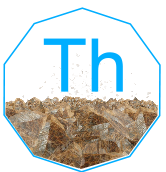Thorium

Thorium (Th)
General Information
- Symbol: Th
- Atomic Number: 90
- Atomic Weight: 232.0377 u
- Element Category: Actinide
- Group: N/A (Actinides series)
- Period: 7
- Block: f-block
Physical Properties
- Appearance: Silvery metallic
- Density: 11.724 g/cm³
- Melting Point: 1750 °C (3182 °F)
- Boiling Point: 4788 °C (8650 °F)
- Phase at STP: Solid
- Electron Configuration: [Rn] 6d² 7s²
- Oxidation States: +4 (most common)
Chemical Properties
- Reactivity: Thorium is relatively reactive, tarnishing slowly in air. It reacts with water and most acids to form thorium compounds.
- Compounds: Forms compounds such as thorium dioxide (ThO₂), thorium tetrafluoride (ThF₄), and thorium nitrate (Th(NO₃)₄).
Uses and Applications
- Nuclear Fuel: Thorium is considered a potential nuclear fuel due to its abundance and ability to be converted into fissile uranium-233.
- Alloys: Used in magnesium alloys for its strength and high melting point.
- Mantles: Thorium dioxide is used in gas mantles for portable gas lights due to its high melting point and ability to emit bright light when heated.
- Radiation Shielding: Used in radiation shielding due to its high density.
- Electronics: Used in some electronic equipment as a coating material for tungsten filaments.
Occurrence and Extraction
- Natural Occurrence: Thorium is widely distributed in small amounts in the earth’s crust. It is found in minerals such as thorite, thorianite, and monazite sands.
- Extraction: Extracted through complex processes involving the crushing of ore, concentration, and chemical separation.
Isotopes
- Stable Isotopes: Thorium-232 (the only naturally occurring isotope)
- Radioactive Isotopes: Thorium has several radioactive isotopes, including Thorium-230 and Thorium-228, which are used in scientific research.
Safety and Handling
- Hazards: Thorium and its compounds are radioactive and can pose significant health risks if ingested or inhaled. It can cause lung, liver, and pancreatic cancer if particles are inhaled or ingested.
- Precautions: Handle with care, using appropriate protective equipment and working in well-ventilated areas. Proper disposal methods for radioactive materials should be followed.
History
- Discovery: Discovered by Jöns Jakob Berzelius in 1828.
- Name Origin: Named after Thor, the Norse god of thunder.
Additional Facts
- Crystal Structure: Face-centered cubic (fcc) at room temperature
- Magnetic Properties: Weakly paramagnetic
- Thermal Conductivity: 54 W/m·K
- Electrical Resistivity: 15.87 µΩ·m at 20°C
Summary
Thorium is a versatile actinide with significant potential for use as a nuclear fuel. It is used in various applications, including alloys, gas mantles, radiation shielding, and electronics. Discovered in 1828 and named after the Norse god Thor, thorium is found in several minerals and requires careful handling due to its radioactive nature.
40 Question and Answer Pairs About Thorium
What is the atomic number of Thorium?
- 90
What is the symbol for Thorium?
- Th
What is the atomic weight of Thorium?
- 232.0377 u
In which group of the periodic table is Thorium found?
- Actinides series (no specific group)
What period is Thorium in?
- Period 7
What block does Thorium belong to?
- f-block
What is the density of Thorium?
- 11.724 g/cm³
What is the melting point of Thorium?
- 1750 °C (3182 °F)
What is the boiling point of Thorium?
- 4788 °C (8650 °F)
What is the electron configuration of Thorium?
- [Rn] 6d² 7s²
What are the common oxidation states of Thorium?
- +4 (most common)
What is the appearance of Thorium?
- Silvery metallic
Is Thorium reactive with air?
- Yes, it tarnishes slowly.
Name a compound of Thorium.
- Thorium dioxide (ThO₂)
What is a common use of Thorium in nuclear fuel?
- Considered a potential nuclear fuel for converting to fissile uranium-233.
How is Thorium used in alloys?
- Added to magnesium alloys for strength and high melting point.
What role does Thorium play in gas mantles?
- Thorium dioxide is used for its high melting point and bright light emission when heated.
How is Thorium used in radiation shielding?
- Used due to its high density.
What is an electronic application of Thorium?
- Coating material for tungsten filaments in electronic equipment.
How is Thorium typically found in nature?
- In minerals such as thorite, thorianite, and monazite sands.
What is the most stable isotope of Thorium?
- Thorium-232
What safety hazard is associated with Thorium dust?
- It is radioactive and can pose significant health risks if inhaled or ingested.
Who discovered Thorium?
- Jöns Jakob Berzelius
Where does the name Thorium come from?
- Named after Thor, the Norse god of thunder.
What is the crystal structure of Thorium at room temperature?
- Face-centered cubic (fcc)
Is Thorium paramagnetic or diamagnetic at room temperature?
- Weakly paramagnetic
What is the thermal conductivity of Thorium?
- 54 W/m·K
What is the electrical resistivity of Thorium at 20°C?
- 15.87 µΩ·m
What is the primary oxidation state of Thorium in its compounds?
- +4
Is Thorium found as a free element in nature?
- No, it is found in minerals.
What is the common name of Thorium(IV) chloride?
- ThCl₄
What is a major application of Thorium in the lighting industry?
- Gas mantles for portable gas lights.
How does Thorium benefit the nuclear industry?
- Potential nuclear fuel for generating uranium-233.
What is the melting point of Thorium in Kelvin?
- 2023 K
What group does Thorium belong to in the periodic table?
- Actinides series
What is the natural abundance of Thorium-232?
- It is the only naturally occurring isotope.
Can Thorium be used in high-temperature applications?
- Yes, particularly in alloys and gas mantles.
What is the key property that makes Thorium valuable in nuclear fuel?
- Its ability to be converted into fissile uranium-233.
How is Thorium used in the chemical industry?
- Mainly in research and specialized applications.
What precautions should be taken when handling Thorium?
- Use appropriate protective equipment to avoid inhalation or ingestion.






